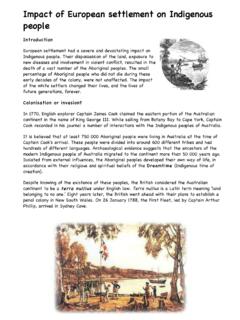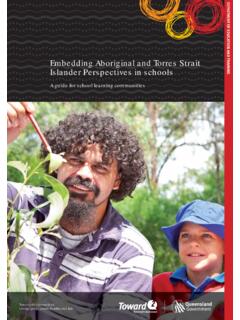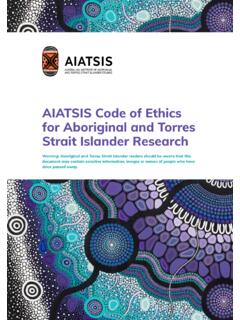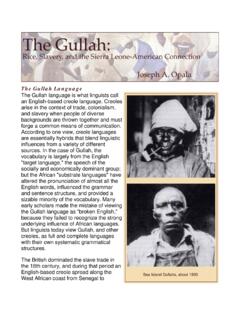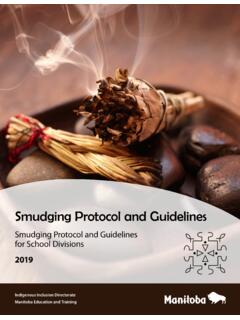Transcription of The Impact of Climate Change on Minorities and Indigenous ...
1 BriefingClimate Change is attracting ever more attention from themedia, academics, politicians and even businesses, asevidence mounts about its scale and seriousness, and thespeed at which it is affecting the world. But rarely does itsimpact on Minorities and Indigenous groups get a mention,even though they are among the worst effects of the changing Climate are bad enough inthemselves more frequent hurricanes and droughts,burning temperatures, new plagues of diseases and worsefloods, for instance. But the general failure to recognize andrespond to Minorities resulting problems greatlyexacerbates their suffering. Disadvantage and discriminationaffect them at every stage, including in the immediateaftermath of Climate -related disasters and during officialplanning at local, national and international levels forcoping with the current and future impacts of close relationship of some Indigenous peoples andminorities with their natural environments makes themespecially sensitive to the effects of global warming.
2 In somecases, peoples ways of life and even their very existence arebeing threatened by Climate Change , and by the rapidlyincreasing cultivation of biofuels, which are being touted aspart of the solution . This briefing sets out some of the evidence on howminorities and Indigenous people are being affected byclimate Change . It shows how discrimination against themmeans that they are not getting the help they need, orinfluence over governments plans for combating andadapting to Climate Change . Finally, it highlights some ofthe opportunities for Change . The briefing uses the term minority to refer to groupsthat are normally numerically smaller, and who share acommon religious, ethnic or linguistic identity. Examplesare the Roma across Europe, Dalits and Muslims in Indiaand Afro-descendants in Colombia. Indigenous peoples refers to groups who have a special connection with thenatural environment and who are often seen as the firstpeople to inhabit a particular territory.
3 Examples includethe Sami of the Arctic and the Miskitu of groups working with Minorities were contacted aspart of the research for this briefing paper, it was strikingthat, in three countries, they were caught up in weather-related crises. In India, the National Campaign on DalitHuman Rights was urging greater attention to the plight ofDalits, Muslims and Adivasis in India, following unusuallysevere monsoon floods in 2007. In Nicaragua, Oxfam staffwere tackling the devastation left by Hurricane Felix on theAtlantic coast, while in the Czech Republic, staff at theRoma rights group Life Together feared major floods in thenorth-east of the country following three days of rain. Inthe event, the rivers carried the water away is impossible to attribute any single instance ofextreme weather to Climate Change , so none of theseexamples can be blamed on it. However, the world s climateis clearly changing. As the Intergovernmental Panel onClimate Change (IPCC) states in its latest Synthesis report,published in November 2007: Warming of the climatesystem is unequivocal, as is now evident from observationsof increases in global average air and ocean temperatures,widespread melting of snow and ice, and rising globalaverage sea level.
4 1In addition to these relatively gradual changes, climatechange also has sudden impacts, in the form of moreweather-related disasters. The toll of emergencies caused byhurricanes, floods, droughts and other forms of extremeweather has more than doubled over the last decade, from175 in 1996 to 391 in 2005, according to the InternationalFederation of the Red Cross and Red Crescent s Wo rl dDisasters the gap: Climate Change , minoritiesand Indigenous peoplesDespite consulting with Climate Change and developmentspecialists within NGOs, academia and intergovernmentalorganizations, we failed to find any English-languageresearch about how global warming is affecting minoritygroups and Indigenous peoples in different countriesaround the world. The only exception to this was the recentTyndall Centre for Climate Change conference report onindigenous peoples (but not Minorities ) and Minorities are mentioned in reports on climatechange, it tends to be incidentally, during studies ofparticular countries.
5 In addition, some academic, non-The Impact of Climate Change on Minorities andIndigenous PeoplesBy Rachel Bairdgovernmental organization (NGO) and media reporting ofspecific disasters has clearly acknowledged that minoritycommunities have fared worse than others. Examples arethe reporting of the New Orleans floods which followedHurricane Katrina in August 2005, and of the Indianfloods in the summer of 2007, in which African-Americansand Dalits respectively suffered especially of the problem is that Climate Change research tendsto focus on economic sectors water, infrastructure,agriculture, settlements and so on rather than humangroups, says Rachel Roach, Climate Change Policy Officerat the development agency Tearfund. Often, climatechange is thought of sectorally, in terms of agriculture,water and so on, rather than in terms of a people, group orlivelihood. 5 This is evident in major reports on climatechange, such as those by the IPCC, as well as in countries National Adaptation Programmes of recent Tyndall Centre conference report6begins bystating that Indigenous peoples are only rarely consideredin academic, policy and public discourses on climatechange.
6 However, Indigenous peoples have won moreattention than other Minorities for the ways in whichclimate Change is harming them. One reason for this is that Indigenous peoples arerelatively well organized at national and international levels,through organizations that represent them to politicians,bureaucrats and journalists. The Inuit, who live in the fast-melting Arctic, have gone so far as to launch a precedent-setting case against the United States in the Inter-AmericanCommission on Human Rights. It is making slow, if any,progress, but has greatly increased awareness of the Inuits plight. The United Nations Permanent Forum on IndigenousIssues will further highlight the issue for all indigenouspeoples in 2008, when it holds a session on Climate changeand the stewardship role of Indigenous people: bio-culturaldiversity, livelihoods and new challenges . In addition tothe session, the Forum has also appointed two of itsmembers to produce a report on the Impact of climatechange mitigation measures on the territories and lands ofindigenous peoples.
7 The activism of the Indigenous lobbyprovides lessons for campaigners for minority rights. Theymight wonder why given the host of disadvantages theircommunities face they should take on this issue too. Theanswer is clear: not only is global warming changing ourworld but, as we shall see from the following sections, Minorities and Indigenous people are among the worst offat every stage in the Climate Change story. Minorities tend to live in places that areworst hit by the impacts of Climate Change their poverty exacerbates theirvulnerabilityJohn Magrath, programme researcher at Oxfam, says: Minorities tend to live in the more marginal areas,exposed areas, that seem to be seeing more climatechanges and are more susceptible to Climate impactsbecause they have got less, and get less, It is a characteristic of all the studiesthat I have seen, that the ethnic communities are thepeople who suffer most from Climate impacts and are themost vulnerable.
8 The IPCC s latest impacts report also clearlyacknowledges that some groups are especially vulnerable,although it rarely uses the term minority . For example, itstates: Impacts of Climate Change are like to be felt most acutelynot only by the poor, but also by certain segments of thepopulation, such as the elderly, the very young, thepowerless, Indigenous peoples, and recent immigrants,particularly if they are linguistically isolated, thosemost dependent on public support. Impacts will alsodiffer according to gender. 7 One of the most shocking examples of Minorities greater exposure to Climate Change is in India, where some170 million people known as Dalits are physically, sociallyand economically excluded from the rest of society. As aresult they and two other Minorities , Adivasis and Muslims,were worst hit by the unusually severe monsoon floods in2007. Many Dalits lived in rickety homes in flood-prone areasoutside main villages, leaving them especially were often last to get emergency relief, if they2 THE Impact OF Climate Change ON Minorities AND Indigenous PEOPLESP overty in New OrleansPeople living in poverty, 2000 (%)New OrleansUnited StatesTotal population2812 Children 18 years and younger3818 Whites129 African-Americans3525 Source: UNDP, HDR 2007received it at all, because relief workers did not realize thatDalits live outside the main villages, or because dominantgroups took control of distribution or were given priority.
9 A survey by Dalit organizations of 51 villages on 8 9 August 2007 found, among other things, that 60 per centof the dead were Dalits, that none of the Dalit colonies (ortolas) attached to the main villages had been visited bygovernment relief officials and that Dalits housing hadsuffered the worst damage because most was of poorquality and in low-lying areas. These findings were set outin a letter from N. Paul Divakar, convenor of the NationalCampaign for Dalit Human Rights, to the Governor living in New Orleans were alsodisproportionately badly hit by the floods caused byHurricane Katrina in 2005. A Brookings Institution reporton the disaster found that those areas hit hardest by theflood were disproportionately non-white. Overall, blacksand other minority residents made up 58 percent of thosewhose neighborhoods were flooded, though theyencompassed just 45 percent of the metropolitanpopulation. 9 Within the city itself, 80 per cent of peoplewho had lived in the flooded areas were the stricken city was harder for people in theflooded areas, because one in five of them had no access toa car, compared to one in ten without access in the dryareas.
10 In Europe, Roma communities housing conditions arenotoriously unpleasant and unhealthy. That some are athigh risk of flooding has been less widely noted, perhapsbecause of the more obvious hazards they face. However, a few studies have found that Roma peoplesuffered especially badly during floods. Making the Casefor Environmental Justice in Central and Eastern Europe examines events in the Slovakian Roma community ofJarovnice, which suffered the worst floods in its history inJune 1998. Some 140 Roma homes were affected, compared with25 non-Roma homes, and of the 47 people who werekilled, 45 were Roma. Of those who died, 42 had lived in ashanty town in the valley of the River Svinka, which hadflooded, while non-Roma lived in the village above thevalley. The report notes: The public, shocked over thefatalities associated with the flood, forced the Governmentto take action, However, while housing for 20 families waseventually constructed in 2006, the vast majority of theresidents still wait for safer housing.



